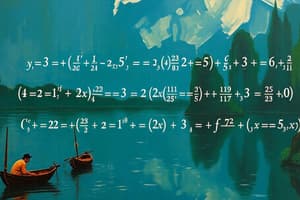Podcast
Questions and Answers
What is the factored form of the expression $x^2 - 9$?
What is the factored form of the expression $x^2 - 9$?
- $(x - 9)(x + 1)$
- $x^2 + 3$
- $(x - 3)(x + 3)$ (correct)
- $(x + 3)(x + 3)$
Which of the following expressions represents the Law of Exponents correctly?
Which of the following expressions represents the Law of Exponents correctly?
- $ rac{a^m}{a^n} = a^{m+n}$
- $a^{m+n} = a^m imes a^n$ (correct)
- $a^m imes a^n = a^{m-n}$
- $(a^m)^n = a^{m+n}$
How does one correctly solve the inequality $-2x < 4$?
How does one correctly solve the inequality $-2x < 4$?
- $x > -2$ (correct)
- $x > 2$
- $x < 2$
- $x < -2$
If simplifying $
rac{
rac{a^4}{a^2}}{a^3}$, what is the resulting expression?
If simplifying $ rac{ rac{a^4}{a^2}}{a^3}$, what is the resulting expression?
Which of the following is a correct example of rationalizing a denominator?
Which of the following is a correct example of rationalizing a denominator?
Which of the following best describes the focus of abstract algebra?
Which of the following best describes the focus of abstract algebra?
What is the correct form of a quadratic equation?
What is the correct form of a quadratic equation?
Which of the following operations is NOT a standard method of solving a one-variable equation?
Which of the following operations is NOT a standard method of solving a one-variable equation?
What does the slope of a line signify in graphing?
What does the slope of a line signify in graphing?
In the context of functions, what is the primary characteristic of a relation to be classified as a function?
In the context of functions, what is the primary characteristic of a relation to be classified as a function?
Which method is used to find the roots of a quadratic equation if factoring is not possible?
Which method is used to find the roots of a quadratic equation if factoring is not possible?
What is the main operation performed in elementary algebra?
What is the main operation performed in elementary algebra?
In a linear equation of the form $ax + b = 0$, what does 'b' represent?
In a linear equation of the form $ax + b = 0$, what does 'b' represent?
Flashcards are hidden until you start studying
Study Notes
Algebra Study Notes
Basic Concepts
- Variables: Symbols (usually letters) used to represent unknown values.
- Constants: Fixed values that do not change.
- Expressions: Combinations of variables, constants, and operators (e.g., (2x + 3)).
- Equations: Statements that two expressions are equal (e.g., (2x + 3 = 7)).
Types of Algebra
-
Elementary Algebra
- Focuses on basic operations and solving simple equations.
- Includes concepts like integers, fractions, and basic polynomials.
-
Abstract Algebra
- Studies algebraic structures such as groups, rings, and fields.
- Involves more theoretical concepts than elementary algebra.
-
Linear Algebra
- Concerns vector spaces and linear mappings between them.
- Key concepts include matrices, determinants, and eigenvalues.
Key Operations
- Addition and Subtraction: Combining like terms (e.g., (3x + 5x = 8x)).
- Multiplication: Distributive property (e.g., (a(b + c) = ab + ac)).
- Division: Involves finding the inverse operation, important for solving equations.
Solving Equations
- One-variable equations: Isolate the variable on one side (e.g., (2x + 3 = 7) → (2x = 4) → (x = 2)).
- Linear equations: Form (ax + b = 0), solved by isolating (x).
- Quadratic equations: Form (ax^2 + bx + c = 0), solved using:
- Factoring
- Quadratic formula: (x = \frac{-b \pm \sqrt{b^2 - 4ac}}{2a})
Functions
- Definition: A relation that assigns exactly one output for each input.
- Notation: (f(x)) indicates a function (f) evaluated at (x).
- Types of Functions:
- Linear functions: Form (f(x) = mx + b).
- Quadratic functions: Form (f(x) = ax^2 + bx + c).
Graphing
- Coordinate System: Consists of an x-axis and a y-axis.
- Slope: Measure of the steepness of a line, calculated as (m = \frac{y_2 - y_1}{x_2 - x_1}).
- Intercepts: Points where the graph intersects the axes (x-intercept, y-intercept).
Factoring
- Factoring Techniques:
- Common factors
- Difference of squares: (a^2 - b^2 = (a + b)(a - b))
- Trinomials: (ax^2 + bx + c) can be factored into ((px + q)(rx + s)).
Exponents and Radicals
- Laws of Exponents:
- (a^m \cdot a^n = a^{m+n})
- (\frac{a^m}{a^n} = a^{m-n})
- ((a^m)^n = a^{mn})
- Radicals:
- Simplifying roots (e.g., (\sqrt{a^2} = a)).
- Rationalizing denominators.
Inequalities
- Definition: A statement that compares two expressions (e.g., (x > 5)).
- Solving Inequalities:
- Similar steps to equations, but reverse the inequality when multiplying/dividing by a negative number.
Applications
- Used in fields such as physics, economics, engineering, and computer science.
- Real-world problem solving, modeling relationships, and analyzing trends.
Basic Concepts
- Variables represent unknown values, often denoted by letters.
- Constants are fixed values that do not change.
- Expressions combine variables, constants, and operators (e.g., (2x + 3)).
- Equations state that two expressions are equal (e.g., (2x + 3 = 7)).
Types of Algebra
- Elementary Algebra: Involves basic operations with integers, fractions, and simple equations.
- Abstract Algebra: Examines algebraic structures such as groups, rings, and fields with a greater theoretical focus.
- Linear Algebra: Deals with vector spaces and linear mappings, emphasizing matrices, determinants, and eigenvalues.
Key Operations
- Addition and Subtraction involve combining like terms (e.g., (3x + 5x = 8x)).
- Multiplication applies the distributive property (e.g., (a(b + c) = ab + ac)).
- Division is finding the inverse operation, crucial for solving equations.
Solving Equations
- Isolate the variable in one-variable equations (e.g., (2x + 3 = 7) simplifies to (x = 2)).
- Linear equations take the form (ax + b = 0) and are solved by isolating (x).
- Quadratic equations, presented as (ax^2 + bx + c = 0), can be solved through:
- Factoring
- Using the quadratic formula: (x = \frac{-b \pm \sqrt{b^2 - 4ac}}{2a})
Functions
- Functions relate inputs to exactly one output and are often denoted as (f(x)).
- Linear Functions are represented as (f(x) = mx + b).
- Quadratic Functions are expressed as (f(x) = ax^2 + bx + c).
Graphing
- The coordinate system consists of an x-axis (horizontal) and a y-axis (vertical).
- Slope measures line steepness, calculated as (m = \frac{y_2 - y_1}{x_2 - x_1}).
- Intercepts are points where the graph crosses the axes, including x-intercept and y-intercept.
Factoring
- Factoring techniques include:
- Identifying common factors.
- Applying the difference of squares formula: (a^2 - b^2 = (a + b)(a - b)).
- Factoring trinomials in the form (ax^2 + bx + c) into ((px + q)(rx + s)).
Exponents and Radicals
- Laws of Exponents include:
- (a^m \cdot a^n = a^{m+n})
- (\frac{a^m}{a^n} = a^{m-n})
- ((a^m)^n = a^{mn})
- Radicals involve simplifying roots (e.g., (\sqrt{a^2} = a)) and rationalizing denominators.
Inequalities
- Inequalities compare two expressions, indicated with symbols like (>) (e.g., (x > 5)).
- Solving inequalities follows similar steps to equations but requires reversing the inequality when multiplying or dividing by a negative number.
Applications
- Algebra is applied in various fields, including physics, economics, engineering, and computer science.
- It aids in real-world problem solving, modeling relationships, and analyzing trends.
Studying That Suits You
Use AI to generate personalized quizzes and flashcards to suit your learning preferences.




